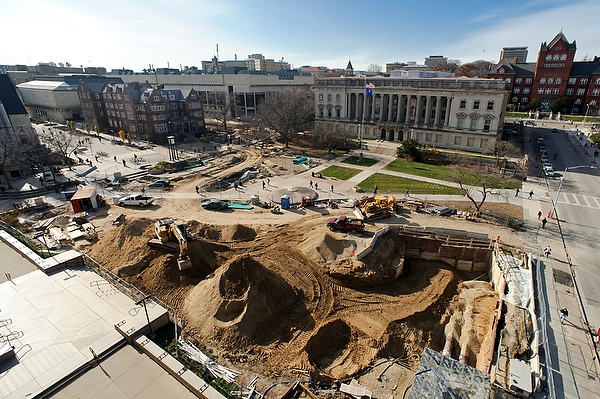Library Mall construction closing loop on utility rebuild

Underground utility construction continues on Library Mall. The new plumbing lines will link Langdon Street to utilities under Dayton Street, replacing utilities put in decades ago.
Photo: Bryce Richter
On a sleety November day with a piercing northwest wind, the premium real-estate location on Library Mall is 15 feet underground, in the new utility tunnel that runs down East Campus Mall toward the Memorial Union.
With high ceilings, a bit of warmth from the steam pipes, and shelter from the wind, the tunnel only seems to lack a window for perfect creature comforts.
Above ground, a visitor might mistake this campus crossroads for a demonstration lot for construction equipment. That’s because the mall is a vital link in a complex, multi-year project to ensure redundant supply of electricity, heat and cooling to the campus.
But after more than a year of construction, the worst is over on Library Mall. With good weather and a bit of luck, the surface could be largely put back together by mid-December.
“We are near completion of this project,” says Dan Dudley, campus utilities engineer with Facilities, Planning and Management.
Last summer, the underground utility project approached Library Mall from the north and west, with large projects on Observatory Drive and Langdon Street. This summer, ditches, tunnels, fences and shoring have obstructed major parts of Library Mall.
The new plumbing will link Langdon Street to utilities under Dayton Street, replacing utilities put in decades ago.
Until a backhoe goes to work, it’s easy to forget that campus is served by almost a dozen types of underground utilities. Pipes carry steam for heat, chilled water for cooling, drinking water, sewage, and condensed water from the heating system. Wires and fiber optic cables carry electricity, telephones and data.
All told, campus has four miles of utility tunnels, and 15 miles of the smaller, cheaper box conduits — which still cost in the range of $3,000 per foot.
Reliability is key at a high-profile research university like UW–Madison.
“Once this utility project is complete, we will have redundancy built into the systems on this end of campus,” says Dudley. “If a steam line goes down for repair, we can route steam around it, and that’s also true for chilled water and electricity.”
In general, underground utilities have a lifetime of 30 to 50 years, Dudley says. “There was a spurt of growth on campus during the 1960s, with major construction of underground utilities, and as they get older, they have to be replaced or upgraded,” he adds.
From the look of the brick arches on top of the old utility tunnel near Memorial Union, some of them are much older than 50 years.
Construction inevitably causes disturbance, Dudley acknowledges, “but it provides revenue and jobs that supports the whole community. It may be an annoyance, but this is called progress.”
You might want to enjoy the incipient peace and quiet on Library Mall while you can. In the next six months, the university will start discussions with the city of Madison about rebuilding the mall, and the adjoining State Street Mall.
